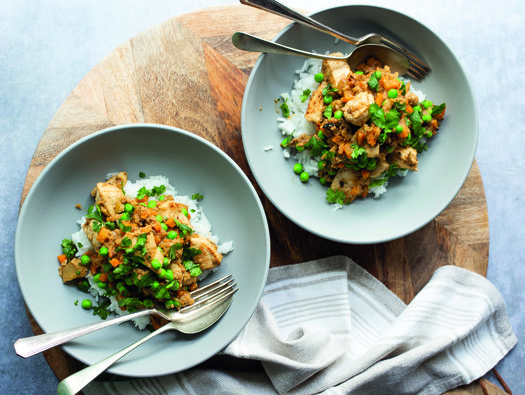Almond chicken

A traditional South Indian family recipe.

A traditional South Indian family recipe.
1 tablespoon ghee (or unsalted butter)
1 small onion, grated
2 cloves garlic, crushed or finely chopped
2cm piece of ginger, grated or finely chopped
150g carrots, peeled & chopped into small chunks
1 teaspoon coriander powder
1 teaspoon cumin powder
1 pinch chilli powder (use more if you like)
30g ground almonds
200g boneless & skinless chicken thigh or breast, cut into 2cm cubes
120g long grain or basmati rice
100g frozen peas
40-80ml water
2 tablespoons fresh coriander, chopped
On a high heat, in a frying pan, melt the ghee, then add the grated onion, garlic, ginger, carrot and spices and cook for 10 minutes. If the mixture starts to stick, add a little water.
Add the ground almonds with 40ml of water to the pan. If ingredients start to stick to the pan, add more water (another 20-40 ml).
Add the cubed chicken to the pan, brown, then turn heat down to medium. Cook for 10 minutes, adding more water if needed to stop the sauce sticking to the pan.
Meanwhile, rinse the rice under cold water and drain. Put into a pan of boiling water, bring back to boil then turn heat down to medium, put a lid on and cook for 12 minutes.
The almond chicken is ready when the chicken is cooked through, and the sauce is thick and a sandy colour. At this stage, add the peas to warm through.
Serve the rice, top with the almond chicken and garnish with fresh, chopped coriander.
The rice is the main source of carbohydrate in this main meal, and the value has been provided for those who have been trained in insulin adjustment.
This dish is low in potassium, if you have been advised to reduce your potassium ensure you keep to the quantities and serving sizes stated.
This recipe is low in phosphate, however does contain some phosphate, therefore, if you have been prescribed a phosphate binder ensure you take with this dish.
This dish is high in protein and therefore suitable to those advised to eat more protein, such as those receiving dialysis. If you have been advised to eat less protein, consider using a 400g drained tin of chickpeas in place of the chicken, or halve the quantity of chicken (100g) and replace with a 200g drained tin of chickpeas or lentils.
Consider using chicken with bones and de-bone yourself. Also, omit the fresh chopped coriander herbs to reduce the cost. If you are unable to get ground cumin or coriander, you could use curry powder to replace.
Replace the chicken with a 400g tin of drained lentils or chickpeas. Alternatively use 200-300g of tofu.
Replace the chicken with a 400g tin of drained lentils or chickpeas. Alternatively use 200-300g of tofu. Replace the ghee with a vegetable oil.
Replace the white rice with a brown wholegrain rice to increase the fibre and replace the ghee or unsalted butter with a vegetable oil such as sunflower for a healthier source of fat. However, this will result in a slightly runnier sauce.
This curry sauce freezes well. Cool soon after cooking and freeze for up to three months. Defrost thoroughly in the fridge before reheating.
If you prefer, other vegetables can be used instead of peas and carrots. Cauliflower and green beans work well, as do aubergine and spinach, but these are high in potassium, so if you need to reduce your potassium don’t choose these.
By giving us your email address, you're giving us permission to send you the latest news from Kidney Care UK. Further information about how we protect and use your personal data is available in our Privacy policy. If you would like to change the way we communicate with you at any time please email [email protected]. You can unsubscribe at any time by using the link at the bottom of every email we send.